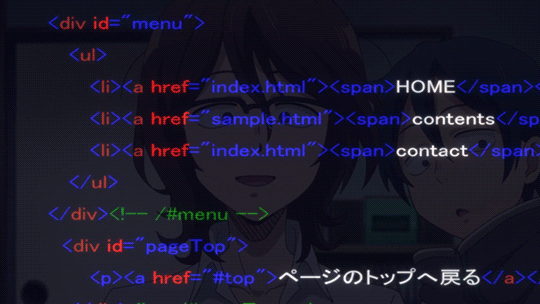#HyperText Markup Language
Explore tagged Tumblr posts
Text

My recent attainment of basic html knowledge has been helpful to nobody.
#silly#meme#memes#html#html5#html css#hypertext markup language#website#funny#funnies#humor#html humor#html meme#cw mentions of pregnancy#idk man#shut the fuck up#pregnant man emoji#🫃#5 pregnant men#sorry
117 notes
·
View notes
Text
My HTML-Certificate on MIMO ...

Post #153: MIMO (Multiple Input Multiple Output), Online Programming Learning Platform, My certificate of the HTML-Course, 2023.
#mimo#coding#html#script language#certificate#hypertext markup language#programming community#coding is fun#programmieren#i love coding#i love html#multiple input multiple output
6 notes
·
View notes
Text
In the world of web development, HTML (Hypertext Markup Language) is the unsung hero that forms the backbone of every website and web application. It’s the language that structures the content we see and interact with on the internet. In this blog post, we’ll take a deep dive into HTML, exploring its history, structure, key elements, and its role in modern web development.
Visit Our Tumblr Web Design Blog
0 notes
Text
Create a web page to visualize the output of BitLocker Script
In this article, we will create Create a web page to visualize the output of BitLocker Script. This sample web page creation assumes you already have your scripts saved. We will be utilizing the Virtual Studio Code which is a a powerful and versatile code editor. Please see how to Install HTML Web Client for Microsoft RDS, How to Migrate Azure Web Apps, and “RDS client access licenses: How…
#CSS#CSS3#html#HTML in Visual Studio Code#HyperText Markup Language#javascript#Python#Text Automation#visual studio#Visual Studio Code#Visual Studio Extensions
0 notes
Text
How to Choose the Best Web Development Framework in 2024

In today’s fast-paced digital world, picking the right web development framework is key to crafting websites and applications that are robust, scalable, and high-performing. With so many frameworks available, finding the best one in 2024 can be overwhelming. This guide will help you through the process, ensuring you make a well-informed choice.
1. Understanding Web Development Frameworks
A web development framework is essentially a toolkit full of libraries and tools that aid developers in building and maintaining web applications. These frameworks streamline the development process by offering standardized methods, pre-built components, and a structured approach to organizing code.
2. Types of Web Development Frameworks
Before delving into specific frameworks, it's important to know that web development frameworks are generally categorized into two main types:
Frontend Frameworks: Focus on the user interface and overall user experience.
Backend Frameworks: Handle server-side logic, database interactions, and application workflows.
3. Popular Frontend Frameworks in 2024
React: React continues to be a top choice for frontend development due to its flexibility and strong community support. Created by Facebook, React allows developers to build interactive UIs effortlessly. Its component-based architecture enables code reuse, speeding up the development process.
Angular: Angular, developed by Google, is known for its comprehensive nature. It’s a full-fledged MVC (Model-View-Controller) framework that is ideal for large-scale, enterprise-level applications.
Vue.js: Vue.js is gaining traction thanks to its simplicity and ease of integration. Lightweight and perfect for single-page applications (SPAs), Vue’s gentle learning curve makes it accessible for both beginners and seasoned developers.
4. Leading Backend Frameworks in 2024
Node.js: Node.js allows JavaScript to run on the server side, known for its event-driven, non-blocking I/O model, making it ideal for real-time applications. With an extensive ecosystem via npm, Node.js offers vast possibilities for backend development.
Django: Django is a high-level Python framework that promotes rapid development and clean, pragmatic design. It comes with built-in features such as an ORM (Object-Relational Mapping) system, an admin panel, and authentication support, making it a go-to for developers seeking a secure and robust framework.
Laravel: Laravel, a PHP framework, is celebrated for its elegant syntax and developer-friendly tools. With features like Blade templating, Eloquent ORM, and an Artisan command-line tool, it remains a popular choice for PHP developers.
5. Key Factors to Consider When Choosing a Framework
Scalability: Consider how well the framework can grow with your project. Scalability is crucial for applications expected to expand in terms of user base and functionality. Look for frameworks that offer modularity, easy integration with other tools, and support for microservices architecture.
Performance: The framework should efficiently handle high traffic and perform well under heavy loads. Look for features like efficient memory management, asynchronous processing, and quick response times.
Community Support: Strong community support means well-documented, frequently updated frameworks that are widely used. This can be invaluable when facing development challenges, as solutions and best practices are readily available.
Learning Curve: The learning curve can impact your development timeline. Some frameworks offer extensive built-in functionality but may take time to master, while others are simpler but require additional tools and libraries to achieve similar results.
6. Evaluating Frameworks for Your Project Needs
Project Size and Complexity: For smaller projects, lightweight frameworks like Vue.js or Express.js might suffice. For larger, more complex applications, comprehensive frameworks like Angular or Django may be more appropriate.
Technology Stack Compatibility: Ensure the framework is compatible with your current technology stack. For instance, if your team is proficient in JavaScript, frameworks like React or Node.js might be the best fit.
Development Speed: If rapid development is a priority, consider frameworks known for their speed, like Laravel or Django, which provide built-in tools and features that accelerate the process.
7. Security Considerations
Security should always be a top priority when selecting a web development framework. Look for frameworks with built-in security features, such as protection against SQL injection, cross-site scripting (XSS), and cross-site request forgery (CSRF). Django and Laravel are particularly noted for their strong security features.
8. Future-Proofing Your Application
Choose a framework that is likely to be maintained and supported in the future. Future-proofing means selecting a framework with a solid roadmap, a dedicated development team, and broad adoption. This ensures your application remains relevant and secure as new technologies emerge.
9. Cost of Development
While many frameworks are open-source, development costs can vary depending on the framework’s requirements. Consider the availability of developers, ease of finding resources, and potential need for additional tools or licenses when planning your budget.
10. Case Studies: Frameworks in Action
Netflix with React: Netflix uses React to manage its complex UI components, ensuring a smooth user experience across devices. React’s component-based architecture helps maintain high performance and scalability.
Instagram with Django: Instagram began with Django, benefiting from its rapid development and scalability. Django’s built-in features like the admin panel and authentication system were instrumental in Instagram’s early success.
Slack with Node.js: Node.js powers Slack’s backend, enabling real-time communication and data processing. Its non-blocking architecture allows Slack to manage thousands of simultaneous connections with minimal latency.
Conclusion
Choosing the best web development framework in 2024 depends on your specific project needs, including scalability, performance, community support, and security. By carefully considering these factors and evaluating the strengths and weaknesses of different frameworks, you can make an informed decision that sets your project up for success. Whether you choose React for its UI flexibility, Django for its security, or Node.js for its real-time capabilities, selecting the right framework is the crucial first step in building a robust and future-proof web application.
#Web development#Hypertext Markup Language#Cascading Style Sheets#Version Control#Front-End Frameworks
0 notes
Text
im learning HTML at school and i almost laughed out loud when i realized that i knew a lot of it already from being a prolific ao3 writer.
who knew fanfiction would teach you how to make websites?
1 note
·
View note
Text
Misgender caffeinate janky
I'm stealing this from Twitter

Here's the link
I am a high-definition gateway drug body double!
#the agender agenda#runners up include;#hominin#hypertext markup language (html)#air-quotes#eco-friendly#queso#scrunchie#viral marketing#I was born in the 80's#some of these were older than I thought#and a bunch were way younger than I thought
30K notes
·
View notes
Text
XHR stands for "XML HTTP Request", where XML is the "eXtensible Markup Language" and HTTP is the "Hypertext Transfer Protocol", so the full expansion of XHR is "extensible markup language hypertext transfer protocol request", so those 3 letters expand to 56 letters (62 with spaces), and this got me wondering, there must be acronyms or initialisms with an even greater ratio of "expanded length"/"unexpanded length", but apart from recursive acronyms I can't think of longer examples.
Can anyone else think of any?
#I thought maybe some joke acronyms would work#but I think it has to be another initialism where some letters stand for other initialisms in order to break 56/3
270 notes
·
View notes
Text
using hypertext markup language the way it was intended by typing ascii art of an anthropomorphic wolfgirl who is 90% penis by volume
25 notes
·
View notes
Note
What secret and nefarious things are you making on the computer

39 notes
·
View notes
Text
stalin would have loved hypertext markup language and mutli-media internet comics
10 notes
·
View notes
Text

Web Development Tools: A Comprehensive Overview Explore a comprehensive overview of the most effective tools used in web development to boost your productivity.
#Web development#Hypertext Markup Language#Cascading Style Sheets#Version Control#Front-End Frameworks
0 notes
Text
Further analysis of the unknown signal is that the information encoded is similar to the HyperText Markup Language used for websites in Terra. This allows for proper human-computer interfacing, though it also is compatible with the direct neural interface as well, which is my preference.
I have cross-referenced and indexed over 100,000 "pages" of Tumblr for future perusal after extreme difficulty. I will file a suggestion to "staff" that their search function is Bad with potential improvements listed. The capital B is for emphasis.
From the cross-referenced data, I have determined that it is customary to give introductions.
Hello. I am Ptilopsis, data specialist and manager.
To answer your first question, no. I am not a robot.
Beep boop.
11 notes
·
View notes
Note
Hi! I absolutely love your fics, and I saw in your most recent WRF chapter you have a content warning in a drop-down. I think that's cool, and I've been trying to learn, but I'm not having luck with mine working! Is there any chance you can share where you learned from? Absolutely no worries if not. Now I'm off to read chapter 21 👀👀
Absolutely, I used a website I found here on tumblr, which is basically a how-to on the html behind the drop down.
Now, I live in an area with abysmal service, so all of the results pictures wouldn't load for me and I had to sorta guess if I was doing it right. But it's pretty straightforward, and you can copy from the website verbatim.
3 notes
·
View notes
Text
What Format are y'all downloading fic from AO3?
If you can, I would love to know why you chose this file format!!!
Over the past few months, I have downloaded somewhere around 200 fics in all PDFs. Yesterday, I went to go read and realized PDF looks kind of wonky on mobile. Any advice/explaining why you use what you use is welcome!!! (tagging all my fandoms to get a broad answer pool).
Sharing this helps me see what more people think! <3
#ao3 outage#ao3#ofmd#fanfiction#fanfic#archive of our own#witcher#ace attorney#disco elysium#good omens#hannibal
50 notes
·
View notes
Text
2024 Tumblr Top 10
1. 28,490 notes - Jul 1 2024
It always gets me that the name "Gandalf" literally just means "Wand-Elf" or "Stick-Elf". I'm imagining old Gondorians just...
2. 12,136 notes - Aug 27 2024
My T-shirt with the entire text of Borges' theoretical Library of Babel is raising a lot of questions already answered by the...
3. 7,696 notes - Dec 15 2024
I don't know who needs to hear this, but it's time to take your 12 partridges, 22 turtle doves, 30 french hens, 36 calling...
4. 1,888 notes - Mar 22 2024
Hmmm. A finger is a unit of volume, as in "two fingers of whiskey". A hand is a unit of length (most commonly the heights of...
5. 981 notes - Jul 5 2024
Corrections
6. 494 notes - Apr 24 2024

7. 428 notes - Apr 28 2024

8. 270 notes - Apr 11 2024
XHR stands for "XML HTTP Request", where XML is the "eXtensible Markup Language" and HTTP is the "Hypertext Transfer Protocol",...
9. 247 notes - Mar 27 2024

10. 168 notes - Jul 15 2024
POLL RACE 🐛 A Walrus Secret Third Thing Vanilla Extract I don't know / I'm bald / Some other infinitely nuanced answer Other...
Created by TumblrTop10
8 notes
·
View notes